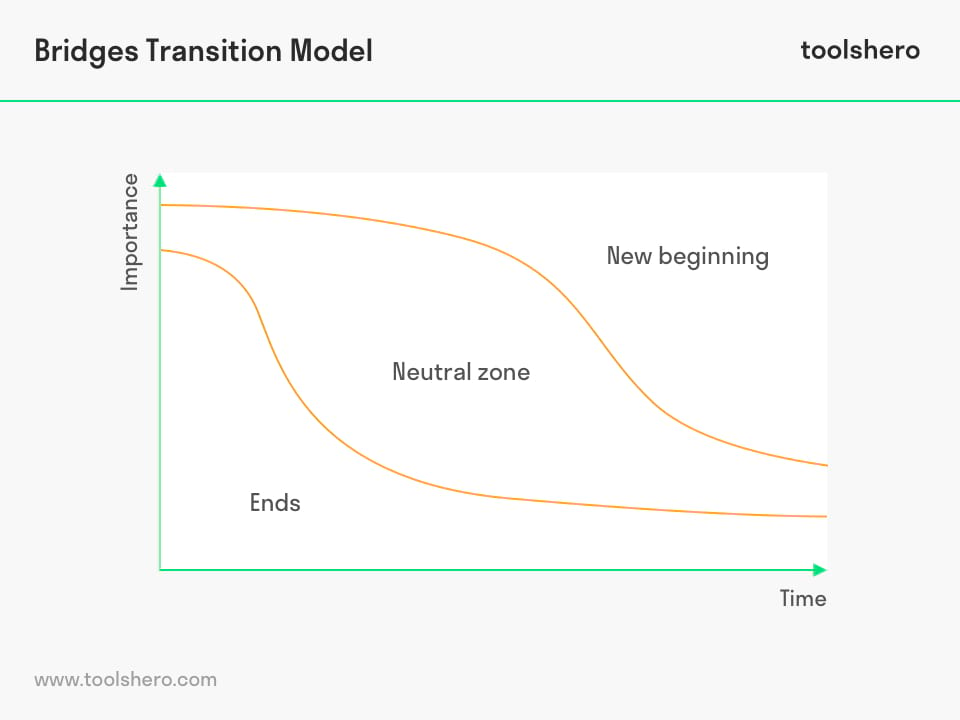Bridges Transition Model explained

Bridges Transition Model: this article provides a practical explanation of the Bridges Transition Model, developed by William Bridges. It covers what the Bridges Model of Transition is, what the three stages of transition are in more detail and what change driven by competitive challenges entails. After reading, you will have a basic understanding of this change management tool. Enjoy reading!
What is the Bridges Transition Model?
The Bridges Transition Model is a model that helps a business or person with organisational change.
The strength of this model is that it focuses on the transition to change. It’s this transition that’s often uncomfortable for people, leading to resistance. People who are forced to go through change also feel confusion and distress throughout the transition process. This is because change is an external event. It happens to you. We know why people are resistant to change and with that knowledge, and this model, we can remove that resistance.
Change is often implemented to make things more efficient, safe, or easy.
Although these reasons are meant to benefit the organisation and performance, employees often turn out to be the biggest obstacle.
According to the Bridges Transition Model, they don’t have to be. In this model of change, Bridges helps to clarify the personal aspect of change management, showing employees as supporters rather than obstacles. According to the authors, change will only succeed if the leaders and managers address the transition that people experience during change.
In short, Bridges’ Transition Model identifies three stages people go through as they gradually enter and accept the new organisational landscape. The Transition Model mainly focuses on psychological change during the transitions between each stage. It’s all about critical psychological realignments.
The model was developed and published by William Bridges (1933 – 2013). He was an American author, organisational consultant, and public speaker.
Bridges Transition Model: stages of transition
Transition is a psychological process that individuals go through, including as part of organisations.
The key to change management is not necessarily the result, but in particular the way people let go of the past and accept the new situation. Guiding people through this transition is essential to ensure that everyone accepts the change. The transition begins when people leave the past behind.
Everyone goes through the process of change at their own pace. Some are quicker to let go of the past and more excited about the new beginning. The process itself, however, is the same for everyone: creating new processes.
William Bridges identified the following three transition stages.

Figure 1 – William Bridges Transition Model
Stage 1 ends
Paradoxically as it may sound, transition starts with an end. The first phase of transition of the Bridges Transition Model starts when employees or other individuals realise that the change is truly happening.
That may have different consequences depending on the person. Take John for instance: after 25 years it looks like he’s losing his job because of automation. People at this stage start to establish what they will lose, how they can limit their losses, and what they can salvage for the future.
In an organisation these often may include relationships, processes, team members or locations.
This phase can be an emotional roller coaster for employees.
Feelings of anxiety, sadness, frustration, and loneliness, or even depression might occur. It should be obvious that employees should be given proper support with this, but that rarely happens. There are many things a manager can do to ease the transition to a change:
- Clearly explain the purpose of the change
- Respect and appreciate emotions
- Clarify the benefits of the planned change
- Clarify exactly what will change and what will remain the same
- Communicate a lot
Stage 2 the neutral zone
The Bridges Transition Model’s neutral zone is the core of the change process.
During this period between the old reality and the new one, individuals learn to handle the consequences. It’s in this stage that individuals create a new sense of identity and where psychological realignment and repatterning take place.
Here, again, some people go through the process more quickly than others. Employees who are in the neutral zone tend to be impatient, confused, or insecure. Getting used to new processes, procedures, or relationships may make people experience an increased workload.
The hardest steps have now been taken, but many employees still struggle with various issues or insecurities, including poor morale, anxiety about their position or status, and resentment. There are several measures managers can take to facilitate change:
- Quickly respond to feedback
- Offer training or other forms of help
- Show the benefits of the change
- Handle any issues that arise
Stage 3 of the Bridges Transition Model: the new beginning
The final stage in the Bridges Transition Process Model is a period of new energy and acceptance. The changes have now been fully accepted, and employees are developing new skills necessary for the new work environment. The first results and benefits of all the effort are now starting to show.
The new identity, the result of a properly managed transition, means that employees can develop understanding for the sense of it all. They think about ways in which they can effectively contribute and be part of the new environment.
The emotions that employees experience during this stage are much more positive than during previous stages. That shows in their work and the results that are being achieved. After a smooth transition, employees in this stage will be energetic, eager to learn, and feel engaged with the organisation.
In order to build a strong foundation for the future, there are a few more things the manager can continue to do:
- Work on a sense of meaning
- Be consistent in behaviour, communication, and decision making
- Show successes that the change has brought
- Celebrate results and milestones
Bridges Transition Model: Change Driven by Competitive Challenges
In a rapidly changing environment, it’s essential that organisations respond quickly to stay ahead of the tide.
The William Bridges Transition Model can be applied to various parts of the change. The most important competitive challenge for organisations is that they have to change continuously.
Constant change means that organisations in general and employees in particular have to be very flexible when it comes to handling the status quo.
In other words, organisations have to be in an endless state of change.
Globalisation
The most common factor that drives organisations to change is globalisation. Globalisation means that businesses have to become able to learn, collaborate, and manage diversity and complexity.
Profitability
The necessity and desire for businesses to grow in terms of revenue puts a lot of pressure on organisations. Businesses use creative and innovative ways to reach new customers and develop new products or services.
On a larger scale, businesses look to increase revenue through mergers, acquisitions, or joint ventures. This also helps with other competencies, such as the ability to integrate and combine different organisational processes.
Technology
When it comes to technology, the challenge businesses face is to make efficient use of it. Organisations have to be smart about their choices. Not all options will actually add value.
In the future, businesses have to develop a strategy to make technology an important element of the productive aspects of their operations.
Managing Business Intelligence is also part of this. That’s where the Bridge Transition Model can be applied to facilitate change as well.
Intellectual Capital
Successful organisations are business that are the best at attracting and developing individuals capable of leading a global business.
A business that responds quickly to both its customers and all the opportunities technology has to offer. The challenge for businesses is finding, recruiting, developing, and retaining such talented individuals.
Now it’s your turn
What do you think? Do you recognise the explanation of the William Bridges Transition Model? Is this model useful to you in your changing environment? Do you recognise the different stages from changes you have gone through yourself? What are some of your tips to help employees deal with change? Any suggestions or comments?
Share your experience and knowledge in the comments box below.
More information
- Bridges, W., & Mitchell, S. (2000). Leading transition: A new model for change. Leader to leader, 16(3), 30-36.
- Dima, G., & Skehill, C. (2011). Making sense of leaving care: The contribution of Bridges model of transition to understanding the psycho-social process. Children and Youth Services Review, 33(12), 2532-2539.
- Tilson jr, G. P., Luecking, R. G., & Donovan, M. R. (1994). Involving employers in transition: The Bridges model. Career Development for Exceptional Individuals, 17(1), 77-89.
How to cite this article:
Janse, B. (2019). William Bridges Transition Model. Retrieved [insert date] from Toolshero: https://www.toolshero.com/change-management/bridges-transition-model/
Original publication date: 06/22/2019 | Last update: 11/11/2023
Add a link to this page on your website:
<a href=”https://www.toolshero.com/change-management/bridges-transition-model/”>Toolshero: William Bridges Transition Model</a>












